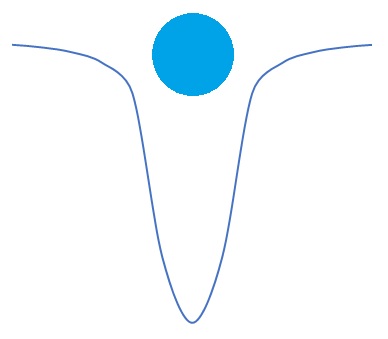Looking more closely at Milgrom’s Scholarpedia entry on
MOND, I found something else that I didn’t like. It was the method by which he arrives at an
equation that I used in the previous post, A Minor Departure from MOND, namely g(in
the MOND regime)=√(GMa0)/r.
I was walking the dogs actually, mulling over things, and realised that I couldn’t for the life of me remember how I arrived at that equation. I must have seen it, got stuck in a mental alleyway and just automatically applied it. Very embarrassing.
While it works, and seems to work better from one perspective with the different value of a0, it won’t wash if there’s no derivation. And there’s no derivation. This is the numerology that I was complaining about a few posts ago.
What Milgrom writes is: “() A0 is the “scale invariant” gravitational constant that replaces G in the deep-MOND limit. The fact that only A0 and M can appear in the deep-MOND limit dictates, in itself, that in the spherically symmetric, asymptotic limit we must have g∝(MA0)1/2/r, since this is the only expression with the dimensions of acceleration that can be formed from M, A0, and r.” The term A0 had been introduced earlier in the text: “A0 is the “scale invariant” gravitational constant that replaces G in the deep-MOND limit. It might have been more appropriate to introduce this limit and A0 first, and then introduce a0≡A0/G as delineating the boundary between the G-controlled standard dynamics and the A0-controlled deep-MOND limit.”
The problem I have is that, in Towards a physical interpretation of MOND's a0, I considered critical density of our universe, and that very specifically uses the Gravitational Constant (G), and I consider the gravitational acceleration at the surface of a Schwarzschild black hole with the same density as that critical density, and that equation also very specifically uses G. However, the resultant acceleration would be right on the border between “the G-controlled standard dynamics and the A0-controlled deep-MOND limit”, so there’s an issue right there.
There’s also an issue with the fact that forces are vector quantities, in the case of gravity directly towards the centre of mass (although due to the summing and negation of sub-forces created by every element of the mass).
When considering the surface of a black hole, the gravitational force is towards the centre of the mass of the black hole. Now, in earlier posts, I have indicated that the density of the universe is the same as the density of a Schwarzschild black hole with a radius equivalent to the age of the universe times the speed of light. What I have never said, at any point, is that the universe is inside a black hole.
My position has been more that the universe *is* a black hole, which may seem rather esoteric, but the point is that I don’t consider there to be an outside in which there would be a black hole inside of which our universe would sit. To the extent that there is a universe in which our universe is nestled, that “outer” universe is on the other side of the Big Bang. So it’s not so much a “where” question, but rather a “when” question.
But even then, it’s not correct to say that the “outer” universe is in our past, because time in that universe was/is orthogonal to our time, and in the same way the spatial dimensions of the “outer” universe were/are orthogonal to our spatial dimensions.
(I know this is difficult to grasp initially, but this video may go some way to explaining a version of the concept.)
This introduces another issue. If we could, in any way, consider our universe to be a black hole in an “outer” universe, then our universe would be smeared across the surface of that black hole and any gravitational force due to the total mass of that black hole would be orthogonal to our spatial dimensions.
So, while it’s tempting to consider a value of a0 that is linked to the mass of a black hole with the dimensions of a FUGE universe, it doesn’t seem supportable.
I had tried a method, considering the curvature of the “fabric of spacetime”, but I suspect that it introduces more problems than it solves.
An image like this illustrates curvature of two dimensions, but it represents curvature of three dimensions. We could eliminate another dimension, to get something like this:
In this image, the notional gravitation that a0 would represent would be a vector field throughout with a downwards trajectory. Without a mass deforming spacetime, that vector field would be orthogonal to it, but with any deformation, there would be a component that is not orthogonal.
It made sense at the time, since it does tie the effect of a gravitational force that should be uniform throughout the universe to a mass that is deforming spacetime but I don’t have any confidence that it works, since the upshot would be additional deformation, which could have a potential runaway effect.
Someone else might have an idea as to how this could work, even if it seems to me to be a dead-end.


No comments:
Post a Comment
Feel free to comment, but play nicely!
Sadly, the unremitting attention of a spambot means you may have to verify your humanity.